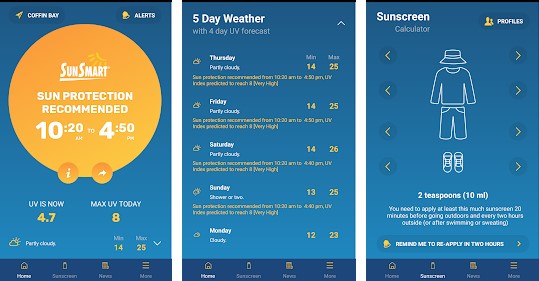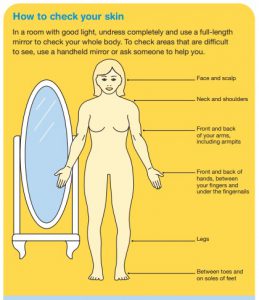Queensland has one of the highest rates of skin cancer in the world. However, by staying SunSmart every day you can reduce your risk.
The vast majority of skin cancers, including melanoma, are caused by over-exposure to ultraviolet (UV) radiation from the sun or artificial sources, such as solariums.
Learn About the 5 Steps to Sun Safety
UV Radiation and skin cancer
UV Radiation and skin cancer
View more
Protect your skin
Protect your skin
View more
Early detection
Early detection
View more
Solariums
Solariums and skin cancer
View more
Vitamin D
Vitamin D
View more
More Information
More information
View more
UV radiation and skin cancer
UV radiation is an invisible danger because we can’t see or feel it. Each time your skin is exposed to UV radiation, the skin cells and how they behave are affected. Overexposure to UV radiation from the sun or solarium use causes permanent damage that adds up over time.
Think UV not heat
Think UV not heat
View more
How to read the UV forecast
How to read the UV forecast
View more
Protecting your skin from the sun and other forms of UV exposure is important at any age, but sun protection is especially important during childhood and adolescence. To learn more about sun protection for babies aged 0-12 months, view the Cancer Council factsheet.
Sun protection is required when the UV levels reach 3 and above. In Queensland, sun protection is required all year, even in winter, due to consistently high UV levels.
Download the free SunSmart app on IOS or Android to access a free daily UV alert.

Protect your skin – stay SunSmart every day
To minimise your skin cancer risk, protect your skin every day with a combination of these five steps:
Slip on protective clothing that:
- Covers as much skin as possible, for example, shirts with long sleeves and high necks/collars.
- Is made from close weave materials such as cotton, polyester/cotton and linen.
- Is dark in colour to absorb UV radiation (white and lighter colours reflect UV radiation onto skin).
- If used for swimming, is made from materials such as lycra, which stays sun protective when wet.
Slop on SPF50 or SPF50+ sunscreen that is:
- Broad spectrum and water resistant.
- Applied liberally to clean, dry skin at least 20 minutes before going outside.
- Reapplied every two hours.
- Used with other forms of protection such as hats and shade.
Slap on a hat that is:
- Broad-brimmed and provides good protection for the face, nose, neck and ears, which are common sites for skin cancers (caps and visors do not provide adequate protection).
- Made with closely woven fabric – if you can see through it, UV radiation will get through.
- Worn with sunglasses and sunscreen to increase your level of protection.
Seek shade by:
- Making use of trees or built shade structures, or bring your own pop-up tent or umbrellas.
- Making sure your shade structure casts a dark shadow and using other protection (such as clothing, hats, sunglasses and sunscreen) to avoid reflected UV radiation from nearby surfaces.
Slide on sunglasses:
- That are close-fitting wrap-around style that meet the Australian Standard AS 1067 and provide an Eye Protection Factor (EPF) of 9 or above.
- With a broad-brimmed hat to reduce UV radiation exposure to the eyes by up to 98 per cent.
- To children as well as adults.
Correct sunscreen application
Correct sunscreen application
View more
Myths about sun protection
View more
Frequently asked questions about sunscreen
View more
Early Detection
Nearly all skin cancers can be successfully treated if found and treated early. But without treatment, skin cancer can be deadly.
Remember to check your skin regularly. See your doctor if you notice a freckly, mole or lump that is NEW or CHANGING in size, shape or colour, or a sore that does not heal over 4-6 weeks.
Use a mirror to check hard to see spots like your back and scalp, or get a family member, partner or friend to check for you.

Some changes to look for include:
- NEW moles, freckles or lump
- moles, freckles or lumps that CHANGE in size, shape or colour
For more information about what to look for, or about melanoma or skin cancer, see these resources.
Spot the difference
Spot the difference
View more
Understanding Melanoma
View more
Understanding Skin Cancer
View more
Solariums
Sunbed or solarium use is associated with the early onset of melanoma – the deadliest form of skin cancer. No solarium can provide a safe tan. In Queensland, a state-wide ban of commercial solariums became effective on December 31, 2014. All other Australian states and territories now also have a ban for commercial solariums. We advise against the use of any type of solariums, including privately owned ones.
Vitamin D – how much sun is enough
In Queensland where UV levels are high all year round, most people receive enough sun exposure to produce vitamin D through their daily incidental activities. These activities include hanging out the washing, checking the letterbox or walking to and from your car.
Overexposure to UV is never recommended, even if you have a vitamin D deficiency. If you are concerned about your vitamin D levels, talk to your doctor to decide whether a vitamin D supplement might be better than sun exposure.
More information
For more information regarding skin cancer, speak to your doctor or call Cancer Council 13 11 20.
The information available on this page should not be used as a substitute for advice from a properly qualified medical professional who can advise you about your own individual medical needs. It is not intended to constitute medical advice and is provided for general information purposes only. See our disclaimer.
